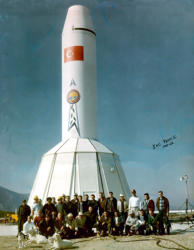HISTORY - Page 53
Re-entry could have posed a problem from another standpoint— aerodynamic stability—but fortunately
no difficulties appeared. Configuration was responsible for this successful development. As to the vital
details, the nose cone had a 12.5-inch radius spherical tip joined to a cone frustum of 65-inch base
diameter, with an over-all length of nine feet. The nose cone also had a rear cover shaped in the form of a
shallow-dished (convex outward) bulkhead, and this was the key part to providing aerodynamic stability
for any attitude to re-entry. Tests of this configuration were first made in wind tunnels; then, on the scale
re-entry models; and, finally, on the full-scale JUPITER. Thus, from re-entry to impact, the nose cone was a
stable component
68
.
Guidance and Control
At the outset of the JUPITER development program, two G&C schemes were under consideration: the all-
inertial guidance system and the radio-inertial guidance system, with the latter being considered as the
alternate or back-up means. Subsequently, In 1958, the radio-inertial part of the program was canceled, for
development efforts in the all-inertial area had progressed systematically and successfully. Thus, although
ABMA and JPL did laboratory work on the radio-inertial system from September 1957 until its cancellation,
principal attention will be devoted to all-inertial development
69
.
The JUPITER all-inertial guidance system development program was based heavily on the success of the
tried and proven REDSTONE G&C system. From the beginning, this move appeared to be logical as the best
_____________________________







68. Ibid.; JUP Prog Rpt for Aug 56, 5 Sep 56; Present, Aeroballistic Aspects of the Re-Entry Phase, Present for Scientific Advisory Committee for DOD, 14 Jan 57, Hist Off files.
69. DF, RIG Off, G&C Lab to IO, et. al., 24 Mar 58, subj: Cancellation of RIG Program, Hist Off files.



Jupiter SM-78 Weapon System
I&C Team 2, Çigli AB, Turkey 1961-1962 Chrysler Corporation Missile Division

HISTORY - Page 53
Re-entry could have posed a problem from another
standpoint— aerodynamic stability—but fortunately
no difficulties appeared. Configuration was
responsible for this successful development. As to the
vital details, the nose cone had a 12.5-inch radius
spherical tip joined to a cone frustum of 65-inch base
diameter, with an over-all length of nine feet. The nose
cone also had a rear cover shaped in the form of a
shallow-dished (convex outward) bulkhead, and this
was the key part to providing aerodynamic stability for
any attitude to re-entry. Tests of this configuration
were first made in wind tunnels; then, on the scale re-
entry models; and, finally, on the full-scale JUPITER.
Thus, from re-entry to impact, the nose cone was a
stable component
68
.
Guidance and Control
At the outset of the JUPITER development program,
two G&C schemes were under consideration: the all-
inertial guidance system and the radio-inertial
guidance system, with the latter being considered as
the alternate or back-up means. Subsequently, In 1958,
the radio-inertial part of the program was canceled,
for development efforts in the all-inertial area had
progressed systematically and successfully. Thus,
although ABMA and JPL did laboratory work on the
radio-inertial system from September 1957 until its
cancellation, principal attention will be devoted to all-
inertial development
69
.
The JUPITER all-inertial guidance system development
program was based heavily on the success of the tried
and proven REDSTONE G&C system. From the
beginning, this move appeared to be logical as the best
_____________________________
68. Ibid.; JUP Prog Rpt for Aug 56, 5 Sep 56; Present, Aeroballistic Aspects of the Re-Entry
Phase, Present for Scientific Advisory Committee for DOD, 14 Jan 57, Hist Off files.
69. DF, RIG Off, G&C Lab to IO, et. al., 24 Mar 58, subj: Cancellation of RIG Program, Hist Off
files.





















